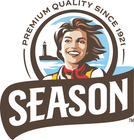10 Essential Tips for Choosing the Best Tinned Fish Company for Your Pantry
When it comes to stocking a well-rounded pantry, few items are as versatile and nutritious as tinned fish. With a seemingly endless array of options available, selecting the right tinned fish company is crucial for ensuring quality, taste, and sustainability. In an era where consumers are becoming increasingly conscious of their food choices, understanding what to look for in a tinned fish company can significantly enhance your culinary experience and contribute to a healthier lifestyle.

This guide will provide you with essential tips to navigate the myriad of brands and products on the market. From sourcing practices to flavor profiles, we will explore key factors that distinguish one tinned fish company from another. Whether you're seeking sustainably caught seafood, unique flavor combinations, or trusted packaging, this comprehensive overview will empower you to make informed decisions that suit your personal preferences and values. Ultimately, choosing the right tinned fish company not only enriches your pantry but also supports responsible practices that benefit our oceans and communities.
Key Factors to Consider When Choosing a Tinned Fish Brand
When selecting a tinned fish brand for your pantry, several key factors should influence your decision-making process. First, consider the quality of the fish itself; look for brands that source their fish from sustainable fisheries. According to a report by the Marine Stewardship Council, nearly 90% of the world's fisheries are overexploited or depleted, making it crucial to choose products that ensure fish populations remain healthy and ecosystems are preserved. Brands that are certified by credible organizations like the MSC or the Aquaculture Stewardship Council not only provide sustainable options but also tend to prioritize quality in their processing methods.
Another important factor is the transparency in packaging and labeling. A study by the Seafood Nutrition Partnership indicates that consumers are more likely to trust and buy from companies that clearly display sourcing information and nutritional value on their packaging. Brands like Wild Planet or Stella Natura, which openly share their sourcing and harvesting practices, enhance consumer confidence and loyalty. Additionally, it’s essential to take into account the nutritional content and any added ingredients. Opting for tinned fish with minimal preservatives or artificial additives aligns with the growing consumer trend towards healthier eating, as highlighted in industry reports from the Food and Agriculture Organization, which emphasize the increasing demand for natural and nutritious food options.
Understanding Sustainability Practices in Tinned Fish Production
When selecting a tinned fish company for your pantry, it is essential to consider their sustainability practices, especially as consumer awareness of environmental impacts grows. The global canned abalone market is anticipated to increase from approximately $840 million in 2024 to $1.31 billion by 2033, with a compound annual growth rate (CAGR) of roughly 4.8%. As trends indicate an increasing demand for sustainably sourced seafood, choosing brands that prioritize sustainable fishing methods becomes crucial for both the consumer and the environment.

Moreover, the expansion of the overall animal protein market—projected to reach approximately $17.619 billion by 2032—highlights the shift towards responsible sourcing and production practices. With the meat market expected to grow from $33.93 billion in 2025 to $46.86 billion by 2032 at a CAGR of 4.72%, there is a clear call for companies to adopt eco-friendly practices. By opting for tinned fish brands that emphasize sustainability, consumers not only support ethical practices but also contribute to the conservation of marine ecosystems, ensuring these resources remain viable for future generations.
Evaluating Taste and Quality: What to Look For in Tinned Fish
When evaluating taste and quality in tinned fish, there are several key factors to consider. First, examine the texture of the fish; it should be firm and moist, avoiding any mushiness that can indicate lower quality. The flavor is equally important; look for brands that prioritize freshness and natural seasoning, avoiding those with artificial additives. Additionally, consider the packing medium—tuna, for instance, can be packed in water or oil, and each brings out different flavors. Choosing oil-packed options can enhance taste, but it’s essential to be mindful of the calorie difference.
Another crucial aspect is the sourcing and sustainability practices of the company. High-quality brands often provide transparency about their fishing methods, ensuring that your purchase supports responsible practices. Keep an eye out for brands that communicate their commitment to sustainability and offer certifications that validate their claims. This not only helps you choose better products but also aligns with a more environmentally sustainable diet. With an array of options available on grocery store shelves, taking the time to evaluate these factors can lead to a significant improvement in the quality of your pantry staples.
Evaluation of Tinned Fish Quality Factors
Exploring Packaging and Shelf Life for Optimal Pantry Use
When selecting the best tinned fish for your pantry, understanding packaging and shelf life is crucial. Many consumers overlook these factors, yet they significantly impact both quality and food safety. According to a 2021 report by the Food & Agriculture Organization, properly sealed and packaged tinned fish can maintain its quality for up to five years, making it a long-lasting pantry staple when chosen wisely.
Opt for brands that utilize BPA-free cans to minimize potential health risks, as studies have shown that BPA can leach into food products.

Lastly, always observe expiration dates, as they vary among different brands and types of fish. Ensuring that your pantry is stocked with fresh, quality products not only enhances your meals but also contributes to waste reduction. The right choice in tinned fish can complement your diet and provide convenience without compromising on health or taste.
The Importance of Brand Reputation and Customer Reviews in Selection
When choosing the best tinned fish company for your pantry, brand reputation and customer reviews play a pivotal role in the selection process. In today's diverse marketplace, where consumers enjoy an increasing range of choices, the perception of a brand can greatly influence purchasing decisions. A well-regarded brand, known for its quality and sustainability practices, can assure customers that they are buying a product that aligns with their values, while negative reviews can deter potential buyers.
Furthermore, customer reviews serve as a vital source of information for consumers. They offer insights into the experiences of others and help gauge product quality and taste. As consumers lean towards products with positive endorsements and ratings, brands must prioritize transparency and responsiveness to customer feedback. In this age of digital communication, positive word-of-mouth can significantly enhance a company's market standing, making it crucial for companies to actively engage with their customers and cultivate a positive brand image.
10 Essential Tips for Choosing the Best Tinned Fish Company for Your Pantry
| Tip | Description | Importance | Example Criteria |
|---|---|---|---|
| 1. Research Brand Reputation | Look for brands with a positive reputation in the seafood industry. | High | Sustainability practices, awards |
| 2. Check Customer Reviews | Analyze feedback from existing customers. | High | Overall ratings, comments |
| 3. Evaluate Product Variety | Consider options for different fish types and flavors. | Medium | Range of species available |
| 4. Look for Sustainability Certifications | Check if the brand meets sustainable fishing standards. | High | MSC or similar certifications |
| 5. Assess Packaging Quality | Ensure that the fish is packaged to maintain freshness. | Medium | Tins that prevent leaking |
| 6. Review Nutritional Information | Check for omega-3 content and other health benefits. | High | Serving size, calories |
| 7. Compare Price Points | Evaluate the price relative to quality. | Medium | Cost per ounce |
| 8. Verify Food Safety Practices | Confirm that the manufacturer follows safety protocols. | High | HACCP compliance |
| 9. Explore Local vs Imported Options | Consider the benefits and drawbacks of local sourcing. | Medium | Support local economies |
| 10. Look for Transparency in Sourcing | Brands should disclose where their fish comes from. | High | Traceability reports |


